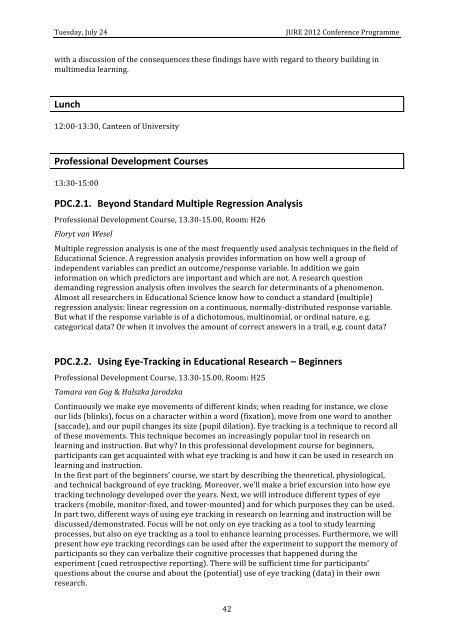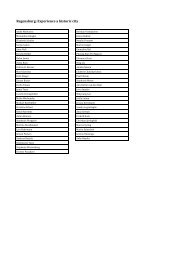JURE 2012 Programme book - EARLI Jure 2012
JURE 2012 Programme book - EARLI Jure 2012
JURE 2012 Programme book - EARLI Jure 2012
You also want an ePaper? Increase the reach of your titles
YUMPU automatically turns print PDFs into web optimized ePapers that Google loves.
Tuesday, July 24 <strong>JURE</strong> <strong>2012</strong> Conference <strong>Programme</strong><br />
with a discussion of the consequences these findings have with regard to theory building in<br />
multimedia learning.<br />
Lunch<br />
12:00-‐13:30, Canteen of University<br />
Professional Development Courses<br />
13:30-‐15:00<br />
PDC.2.1. Beyond Standard Multiple Regression Analysis<br />
Professional Development Course, 13.30-‐15.00, Room: H26<br />
Floryt van Wesel<br />
Multiple regression analysis is one of the most frequently used analysis techniques in the field of<br />
Educational Science. A regression analysis provides information on how well a group of<br />
independent variables can predict an outcome/response variable. In addition we gain<br />
information on which predictors are important and which are not. A research question<br />
demanding regression analysis often involves the search for determinants of a phenomenon.<br />
Almost all researchers in Educational Science know how to conduct a standard (multiple)<br />
regression analysis: linear regression on a continuous, normally-‐distributed response variable.<br />
But what if the response variable is of a dichotomous, multinomial, or ordinal nature, e.g.<br />
categorical data? Or when it involves the amount of correct answers in a trail, e.g. count data?<br />
PDC.2.2. Using Eye-‐Tracking in Educational Research – Beginners<br />
Professional Development Course, 13.30-‐15.00, Room: H25<br />
Tamara van Gog & Halszka Jarodzka<br />
Continuously we make eye movements of different kinds; when reading for instance, we close<br />
our lids (blinks), focus on a character within a word (fixation), move from one word to another<br />
(saccade), and our pupil changes its size (pupil dilation). Eye tracking is a technique to record all<br />
of these movements. This technique becomes an increasingly popular tool in research on<br />
learning and instruction. But why? In this professional development course for beginners,<br />
participants can get acquainted with what eye tracking is and how it can be used in research on<br />
learning and instruction.<br />
In the first part of the beginners’ course, we start by describing the theoretical, physiological,<br />
and technical background of eye tracking. Moreover, we’ll make a brief excursion into how eye<br />
tracking technology developed over the years. Next, we will introduce different types of eye<br />
trackers (mobile, monitor-‐fixed, and tower-‐mounted) and for which purposes they can be used.<br />
In part two, different ways of using eye tracking in research on learning and instruction will be<br />
discussed/demonstrated. Focus will be not only on eye tracking as a tool to study learning<br />
processes, but also on eye tracking as a tool to enhance learning processes. Furthermore, we will<br />
present how eye tracking recordings can be used after the experiment to support the memory of<br />
participants so they can verbalize their cognitive processes that happened during the<br />
experiment (cued retrospective reporting). There will be sufficient time for participants’<br />
questions about the course and about the (potential) use of eye tracking (data) in their own<br />
research.<br />
42



